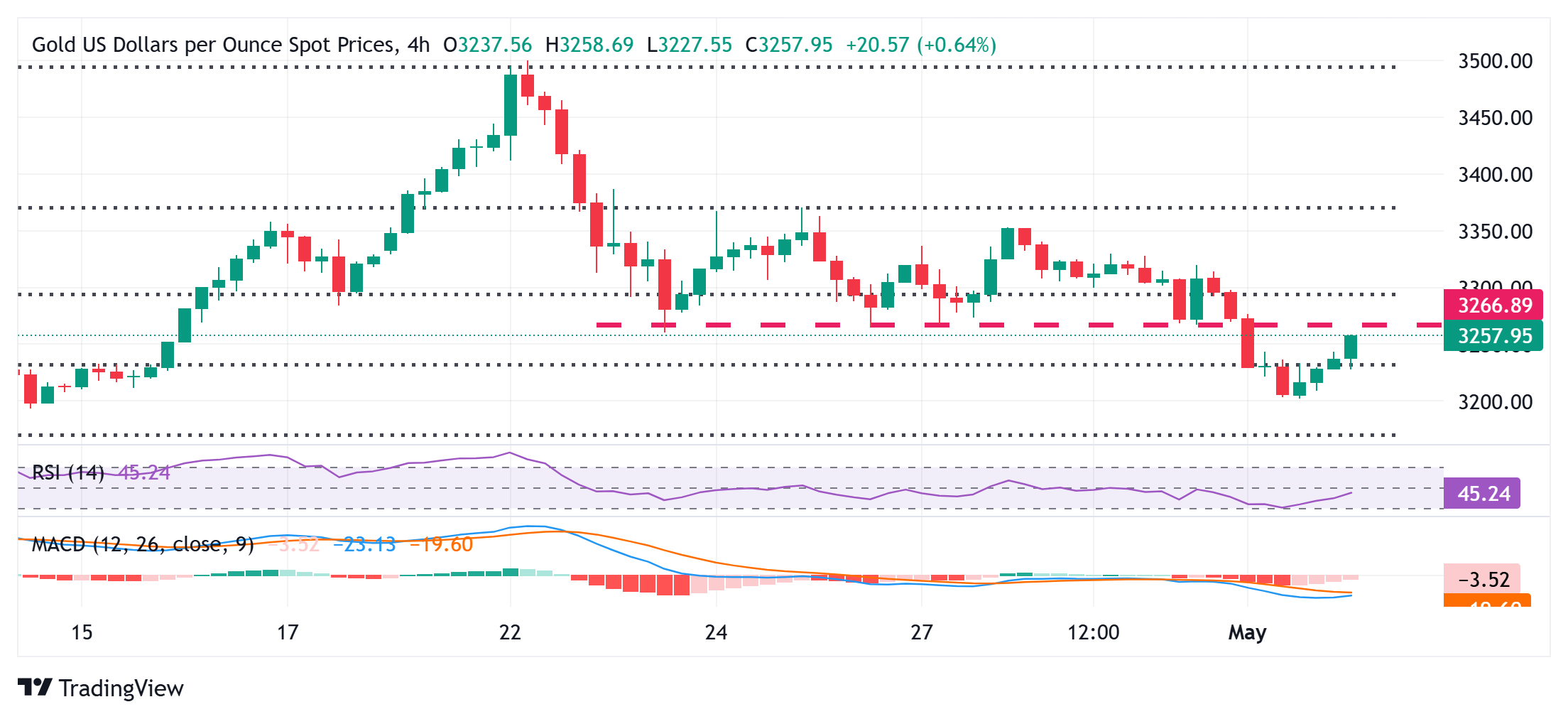Gold struggles to capitalize on intraday uptick amid positive risk tone, ahead of US NFP report

- Gold price gains positive traction and moves away from a two-week low set on Thursday.
- Subdued USD price action lends support to the XAU/USD pair ahead of the US NFP report.
- The optimism over possible US-China trade negotiations might cap the precious metal.
Gold price (XAU/USD) struggles to capitalize on modest intraday gains on Friday and remains below the $3,260-3,265 support breakpoint, now turned resistance, through the Asian session. The optimism over a possible US-China trade deal remains supportive of the upbeat market mood and acts as a headwind for the safe-haven precious metal. However, bets for more aggressive policy easing by the Federal Reserve (Fed) cap the recent US Dollar (USD) move up to a multi-week high and lend some support to the commodity.
Traders, however, seem reluctant to place aggressive directional bets and opt to wait for the release of the closely-watched US monthly employment details, popularly known as the – though they have been losing positive traction – are yet to confirm the negative outlook. This, in turn, prompts some short-covering move and acts as a tailwind for the Gold price.
That said, the aforementioned support breakpoint, around the $3,260-3,265 region, might cap any further gains, above which the XAU/USD pair might reclaim the $3,300 mark. The latter should act as a key pivotal, which if cleared has the potential to lift the Gold price to the $3,348-$3,350 supply zone. Some follow-through buying will suggest that the corrective slide from the all-time peak has run its course and pave the way for a move to the $3,367-$3,368 area en route to the $3,400 mark.
On the flip side, the 50% retracement level, around the $3,229-$3,228 region, now seems to protect the immediate downside ahead of the overnight swing low, around the $3,202-3,201 area. A convincing break below the latter will reaffirm the near-term negative bias and make the Gold price vulnerable to accelerate the downfall towards the $3,200 round figure en route to the $3,160 zone, representing the 61.8% Fibo. level.
Risk sentiment FAQs
In the world of financial jargon the two widely used terms “risk-on” and “risk off” refer to the level of risk that investors are willing to stomach during the period referenced. In a “risk-on” market, investors are optimistic about the future and more willing to buy risky assets. In a “risk-off” market investors start to ‘play it safe’ because they are worried about the future, and therefore buy less risky assets that are more certain of bringing a return, even if it is relatively modest.
Typically, during periods of “risk-on”, stock markets will rise, most commodities – except Gold – will also gain in value, since they benefit from a positive growth outlook. The currencies of nations that are heavy commodity exporters strengthen because of increased demand, and Cryptocurrencies rise. In a “risk-off” market, Bonds go up – especially major government Bonds – Gold shines, and safe-haven currencies such as the Japanese Yen, Swiss Franc and US Dollar all benefit.
The Australian Dollar (AUD), the Canadian Dollar (CAD), the New Zealand Dollar (NZD) and minor FX like the Ruble (RUB) and the South African Rand (ZAR), all tend to rise in markets that are “risk-on”. This is because the economies of these currencies are heavily reliant on commodity exports for growth, and commodities tend to rise in price during risk-on periods. This is because investors foresee greater demand for raw materials in the future due to heightened economic activity.
The major currencies that tend to rise during periods of “risk-off” are the US Dollar (USD), the Japanese Yen (JPY) and the Swiss Franc (CHF). The US Dollar, because it is the world’s reserve currency, and because in times of crisis investors buy US government debt, which is seen as safe because the largest economy in the world is unlikely to default. The Yen, from increased demand for Japanese government bonds, because a high proportion are held by domestic investors who are unlikely to dump them – even in a crisis. The Swiss Franc, because strict Swiss banking laws offer investors enhanced capital protection.
